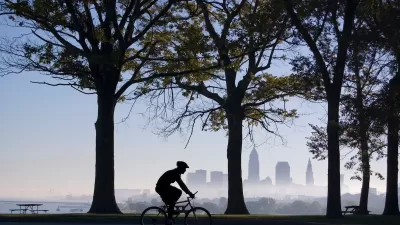The deal is not yet done, but the home team of the LeBronaissance, the most ostensible sign of Cleveland's resurgence, have reportedly asked Cuyahoga County officials to split the cost of an arena renovation.
"The Cleveland Cavaliers have quietly suggested evenly splitting with Cuyahoga County the cost of a multimillion-dollar overhaul of the exterior of Quicken Loans Arena as part of a project to increase the building's square footage," reports Andrew J. Tobias.
"The team's plan would expand the building's footprint, creating more public space inside -- and additional opportunities to sell concessions and other items -- and giving the concrete building a glass exterior," according to the article's sources. And the team, like so many other professional sports franchises in the United States, is looking for public money to help get the renovation done. The team has asked that the county pay half of the project's $140 million price tag, " by borrowing money through the issuance of bonds, and by using revenues from the county's 'sin tax,' a countywide tax on alcohol and cigarettes, a 20-year extension of which county voters approved last May."
Quicken Loans Arena, also known as The Q, was built in 1994. The project was made possible, along with Progressive Field (formerly named Jacobs Field and the home of the Cleveland Indians Major League Baseball team), by $120 million borrowed by the county. The county still owes $55 million on that debt, according to the article.
FULL STORY: Cleveland Cavaliers suggest 50-50 split with Cuyahoga County for costly Quicken Loans Arena renovation

Alabama: Trump Terminates Settlements for Black Communities Harmed By Raw Sewage
Trump deemed the landmark civil rights agreement “illegal DEI and environmental justice policy.”

Planetizen Federal Action Tracker
A weekly monitor of how Trump’s orders and actions are impacting planners and planning in America.

The 120 Year Old Tiny Home Villages That Sheltered San Francisco’s Earthquake Refugees
More than a century ago, San Francisco mobilized to house thousands of residents displaced by the 1906 earthquake. Could their strategy offer a model for the present?

In Both Crashes and Crime, Public Transportation is Far Safer than Driving
Contrary to popular assumptions, public transportation has far lower crash and crime rates than automobile travel. For safer communities, improve and encourage transit travel.

Report: Zoning Reforms Should Complement Nashville’s Ambitious Transit Plan
Without reform, restrictive zoning codes will limit the impact of the city’s planned transit expansion and could exclude some of the residents who depend on transit the most.

Judge Orders Release of Frozen IRA, IIJA Funding
The decision is a victory for environmental groups who charged that freezing funds for critical infrastructure and disaster response programs caused “real and irreparable harm” to communities.
Urban Design for Planners 1: Software Tools
This six-course series explores essential urban design concepts using open source software and equips planners with the tools they need to participate fully in the urban design process.
Planning for Universal Design
Learn the tools for implementing Universal Design in planning regulations.
Clanton & Associates, Inc.
Jessamine County Fiscal Court
Institute for Housing and Urban Development Studies (IHS)
City of Grandview
Harvard GSD Executive Education
Toledo-Lucas County Plan Commissions
Salt Lake City
NYU Wagner Graduate School of Public Service





























